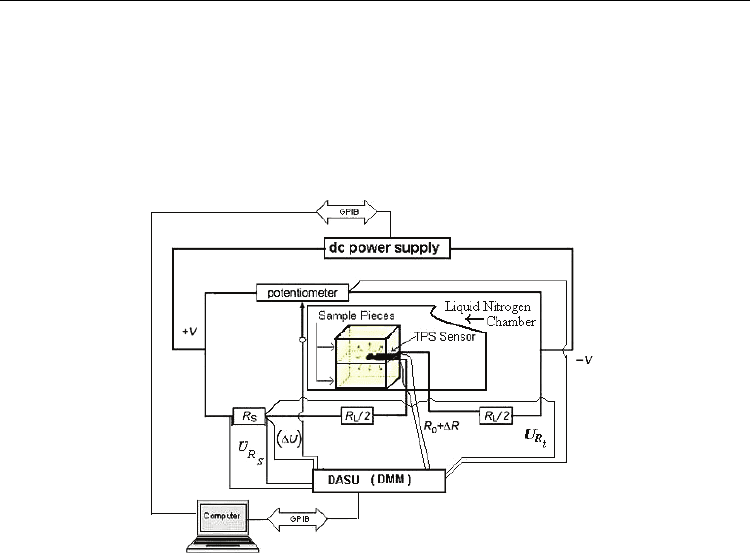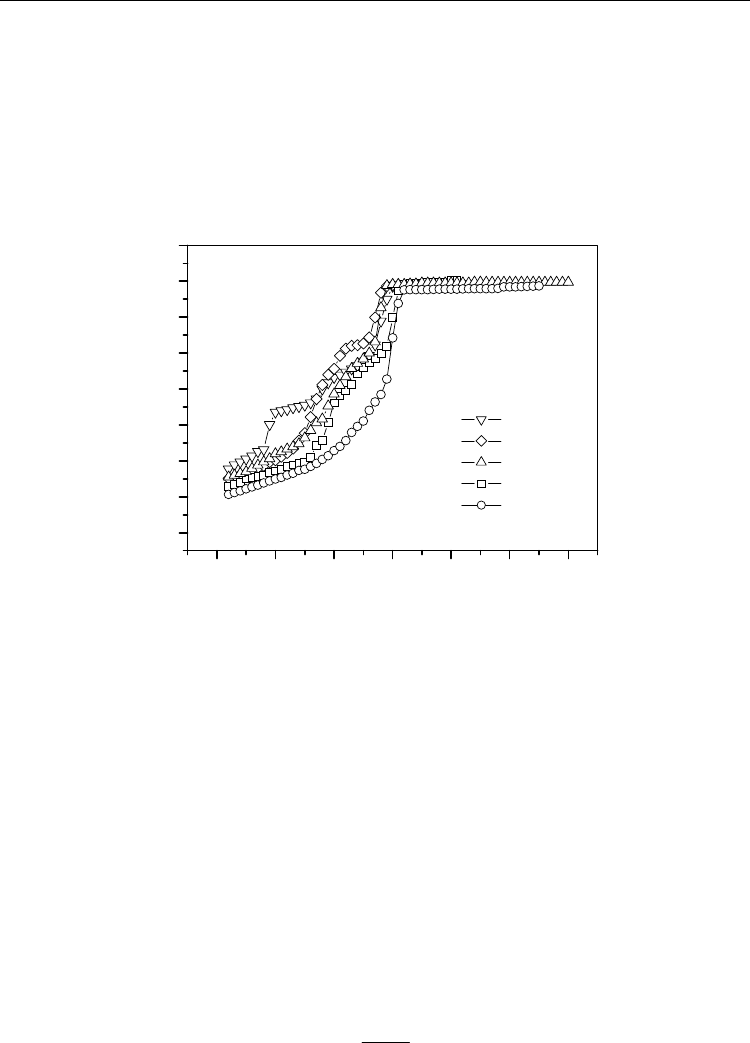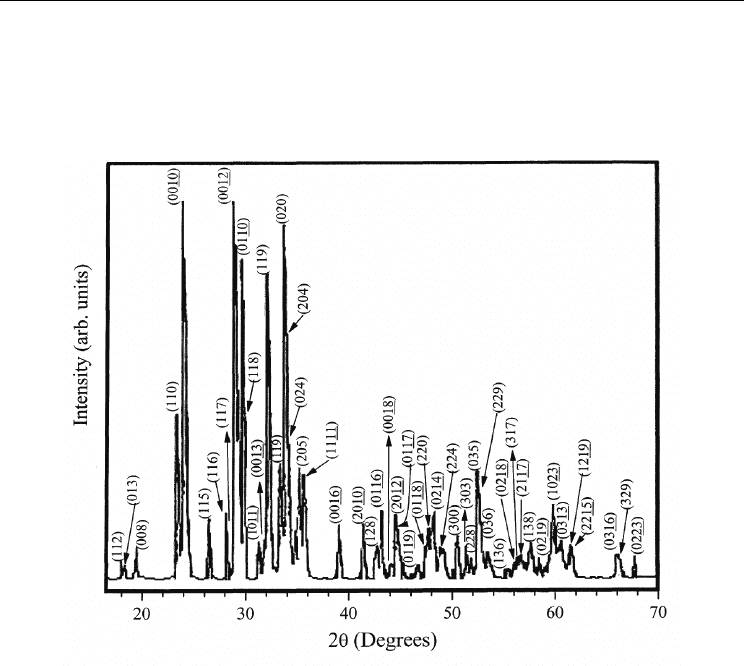Luiz A.M. (ed.) Superconductor
Подождите немного. Документ загружается.


Synthesis and Thermophysical Characterization of Bismuth
based High-T
c
Superconductors
251
agate mortar to give very fine powder. The grind powder was calcined for 21 hours in air at
800
o
C. A series of pellets was produced in two sizes, from this well mixed material and
controlled heating and cooling carried out, in air, using a horizontal tube furnace. Poly Vinyl
Alcohol (PVA) was used as binder in the samples. PVA is one of the few high molecular
weight polymers, which is water soluble and is dry solid, commercially available in granular
or powder form. The properties of Poly Vinyl Alcohol vary according to the molecular weight
of the parent poly vinyl acetate and the degree of hydrolysis. Fully hydrolyzed form with
medium viscosity grade PVA was used in our case. Samples were in the shape of cylindrical
disks having diameters 13mm and 28mm, and lengths 3mm and 11mm respectively. These
samples were sintered at 830
0
C for the intervals of 24 hours in each sintering step as sintering
procedures do affect the properties (Rehman et al., 1998).
The superconducting properties were characterized electrically by using standard four
probe method. Contacts were made by high quality silver paste. The temperature was
measured by using a calibrated Pt-100 thermometer.
Low field ac susceptibility measurements are very important for the characterization of
high-temperature superconductors (Chen et al., 1989; Muller, 1989; Ishida & Goldfarb, 1990;
Celebi, 1999). The sharp decrease in the real part χ
/
(T) below the critical temperature T
c
is a
manifestation of diamagnetic shielding. Ac susceptibility of the sample was measured after
each sintering step. The low field ac susceptibility properties were studied by the use of
mutual inductance bridge method. The measurements were taken from room temperature
down to 80K.
X-ray diffractograph (XRD) of sample was taken after the final sintering. The radiation used
for XRD was CuK
α
and the measurements were made at room temperature. Measurements
were done at room temperature since there is no change in the structure of the
superconducting materials before and after transition (Rehman et al., 1998; Jasiolek et al. 1990).
2.2 Thermal transport properties
Thermal transport measurements, i.e. thermal conductivity, thermal diffusivity and heat
capacity per unit volume were performed using the Advantageous Transient Plane Source
(ATPS) Technique (Rehman & Maqsood, 2002; Rehman & Maqsood, 2003). Circuit diagram
for the method is shown in Fig. 1. Simultaneous measurement of thermal conductivity and
thermal diffusivity is the foremost advantage of this technique. Heat capacity per unit
volume is then calculated using the idea that, if all heat is transported via solid specimen
then the thermal conductivity (λ), thermal diffusivity (κ) and heat capacity per unit volume
(ρC
p
) are expressed by;
p
C
λ
κ
ρ
= (1)
A detailed description of this experimental technique can be found elsewhere (Gustafsson,
1991). The ideal model presupposes that the double spiral sensor, assumed to consist of a set
of equally spaced, concentric, and circular line heat sources, is sandwiched in specimens of
infinite dimensions. In practice all real specimens do have finite dimensions. However, by
restricting the time of the transient, which relates to the thermal penetration depth of the
transient heating, a measurement can still be analyzed as if it was performed in an infinite
medium. This means that the ideal theoretical model is still valid within a properly selected

Superconductor
252
time window for the evaluation. The scatter in thermal conductivity measurements is about
0.14% and is 0.66% and 0.52% in thermal diffusivity and volumetric heat capacity
respectively (Rehman & Maqsood, 2002; Rehman & Maqsood, 2003). Taking into
consideration the limitations of the theory of the technique and the experimental sampling
errors, the thermal conductivity and thermal diffusivity data contain errors of 4% and 7%
respectively. The errors in volumetric heat capacity are around 10% (Rehman & Maqsood,
2002; Maqsood et al., 2000; Rehman & Maqsood, 2003).
Fig. 1. Circuit diagram for the Advantageous Transient Plane Source (ATPS) technique
2.3 Thermoelectric power measurements
An easy to use and simple apparatus was designed and developed for thermoelectric power
(S) measurements. Circuit diagram along with the sample holder assembly is shown in Fig. 2.
The sample is subjected to a temperature difference ∆T using a heating resistor and
corresponding voltage difference ∆V across the sample is measured. Thermoelectric power
is obtained by taking ratio of the voltage difference to the temperature difference. Chromel-
alumel thermocouples are used for measuring the temperature difference, ∆T. The
thermocouples are electrically isolated from the sample and thermally connected to the
sample. Heat losses through the electrical connections are minimized using long leads
wrapped around a Teflon tube. The voltage leads are then silver pasted to the sample in the
vicinity of thermocouples to assure that the voltage and temperature gradients are
measured at the same locations on the sample for accurate thermoelectric power
measurements. The next step includes loading the sample assembly into the sample
chamber and evacuation of the chamber. The chamber is evacuated to eliminate any water
vapour condensation on the sample, which can result in erroneous measurements. Dry
nitrogen gas is then filled in the chamber as a conducting media between chamber walls and
the sample. This sample chamber is then inserted in liquid nitrogen container for cooling.
Data are collected under the computer control. By incorporating multiple measurements in a
single run, considerable time is saved by avoiding remounting, and recooling of the
samples. In this technique the surface mount resistor (50Ω) was used to heat one end of the
sample to establish a measured temperature gradient of approximately 1K.

Synthesis and Thermophysical Characterization of Bismuth
based High-T
c
Superconductors
253
Fig. 2. Block diagram of the apparatus developed for thermoelectric power measurements.
Scanner card is used with the multimeter for simultaneous measurements at different points
as shown. RS-232 is the standard serial interface of the computer
3. Experimental results and discussion
3.1 Dc electrical resistivity
Variation of resistivity with change in temperature is recorded for after each sintering step
and the plots are given in Fig. 3.
100 150 200 250 300
0
5
10
15
20
25
Sint. time(Hrs)
96
120
144
168
216
ρ(x10
-
4
Ω-cm)
Temperature(K)
Fig. 3. DC electrical resistivity as a function of temperature for the sample after each
sintering step
One of the most striking features about the cuprate superconductors is the behavior of the
resistivity of the normal state that is found above the transition temperature of the optimally
doped materials. After the final sintering the measured density of the sample was 3.48 gcm
-3
and T
c, 0
was 110 ± 1K. The added barium (Ba) has increased the T
c, 0
. Residual resistivity was

Superconductor
254
0.19 mΩ-cm and the intrinsic resistivity was 5.9 μΩ-cmK
-1
. The ratio ρ(273K)/ρ(4.2K) is the
residual resistivity ratio (RRR), an important parameter in the design of superconductive
applications. In the case of a superconductor, the denominator has to be taken at a
temperature slightly above the critical temperature (Seeber, 1998). RRR in our case was in
the range 23-33.
3.2 Ac susceptibility
Ac susceptibility measurements were done after each sintering step (Fig. 4).
80 90 100 110 120 130 140
-7
-6
-5
-4
-3
-2
-1
0
1
Sint. time (Hrs)
96
120
144
168
216
Susceptibility χ
/
(arb. units)
Temperature (K)
Fig. 4. Variation of ac susceptibility (real part), with temperature after each sintering step
Initially two transition phases were present. One of the identified phases is the Bi-2212(low
T
c
) phase and the other Bi-2223(high T
c
) phase. With sintering, the low T
c
phase was
smoothed out and only phase left is the Bi-2223(high-T
c
) phase. Although the resistivity
variation with temperature was smoothed out after the third sintering but slight kinks were
observed in the susceptibility against temperature plot showing the more sensitivity of the
measuring method.
3.3 X-ray diffraction studies
Almost all the peaks are indexed. The only phase is the orthorhombic high-T
c
Bi-2223 phase.
Lattice parameters were calculated from the (h k l) values of the indexed peaks. The lattice
parameters are a = 5.42 (1) Å, b = 5.37 (1) Å and c = 37.12 (8) Å. No peaks were found
matching the Bi-2212 low T
c
phase. Indexed X-ray diffractograph is shown in Fig. 5.
The lattice constants agreed with the previous reports (Maqsood et al., 1996). The size of the
grains in polycrystalline materials has pronounced effects on many of its properties. Using
Scherrer’s equation [29];
0.9
cos
B
t
λ
θ
=
(2)

Synthesis and Thermophysical Characterization of Bismuth
based High-T
c
Superconductors
255
where;
B = Broadening of diffraction line measured at half its maximum intensity (radians),
λ =
Radiation source wavelength and t = Diameter of crystal particle,
particle sizes are determined and the diameter of the crystal particles lies between
172 – 512 Å.
Fig. 5. Indexed x-ray diffraction pattern of the sample after the final sintering at room
temperature
3.4 Thermal properties measurements
After the preliminary characterization of the samples and existence of almost a single phase,
large disc-shaped samples (28 mm diameter and 11 mm thickness) were used for the
thermal measurements. Fig. 6 shows the temperature dependence of the thermal
conductivity
λ. As the temperature decreases, the conductivity gradually decreases down to
near T
c
then remarkably increases below T
c
. Further decrease in temperature was not
possible, due to limitation of the cryostat used, to take the maximum in λ. This temperature
dependence agrees with the widely observed behavior of λ for the oxide superconductors
(Uher & Kaiser, 1987; Peacor & Uher, 1989; Mori et al., 1989; Crommie & Zettle, 1990; Cohn
et al., 1992).
Comparing the results between different laboratories, one notes that the thermal
conductivity depends on a particular sample preparation process. The temperature
dependence of the conductivity is really similar for all the samples (Ginsberg, 1992; Ikebe et
al. 1994) . So the order of magnitude of thermal conductivity (measured by non-steady state

Superconductor
256
method in our case) is comparable to the results obtained by different authors (measured by
steady state methods).
Fig. 6 also shows the variation of measured thermal diffusivity
κ with temperature for the
sample. Between 294K and T
c
, κ increases very gradually with decreasing temperature. The
increase of
κ becomes very large around T
c
and become very steep.
The heat capacity per unit volume, ρC
p
, calculated from the thermal conductivity
measurements and thermal diffusivity measurements using equation 1 is shown in Fig. 6.
ρC
p
decreases with decrease in temperature and near T
c
a sizeable kink is observed. This
jump is mostly due to the improved sharpness of the transition related to the reduction of
50 100 150 200 250 300
0.6
0.8
1.0
1.2
1.4
1.6
1.8
2.0
2.2
2.4
Temperature (K)
λ (W m
-1
K
-1
)
κ (mm
2
sec
-1
)
ρC
p
(MJm
-3
K
-1
)
Fig. 6. Variation in thermal transport properties with temperature for the sample
Bi
1.6
Pb
0.4
Sr
1.6
Ba
0.4
Ca
2
Cu
3
O
y
intergrowth structure by adding Pb (Okazaki et al., 1990) and is improved by adding Ba in
our case. Since the calculated lattice constants of our sample are similar to Bi-2223
composition so it is assumed that oxygen is 10, and then the composition becomes
Bi
1.6
Pb
0.4
Sr
1.6
Ba
0.4
Ca
2
Cu
3
O
10
. Also there is no change in the density of the superconducting
sample in the studied temperature range so the value of specific heat C
p
is calculated. The
absolute value of C
p
is 320 Jmol
-1
K
-1
at 180K and that is similar to already reported value of a
similar composition (Okazaki et al. 1990; Gordon et al. 1991). Because the phonon
contribution is by far dominant than the electronic contribution in the temperature range
studied, the specific heat data fitted to the following Debye formula,
34
/
32
0
9
(1)
D
x
T
pph
x
D
Txe
CnR dx
e
Θ
−
=
Θ−
∫
(3)
where C
p-ph
is molar specific heat, x is the reduced phonon frequency, n (= 19) the number of
atoms composing Bi(Ba) 2223 molecules, R the gas constant and
D
is the Debye temperature.
Although a single
D
fitting fails to give a unified strict fitting over the entire temperature
range, but
D
= 510 K gives a satisfactory fitting between T = 120 to 230 K as is shown in Fig. 7.

Synthesis and Thermophysical Characterization of Bismuth
based High-T
c
Superconductors
257
3.5 Thermoelectric power
To check the calibration of this new apparatus (Fig. 2), thermoelectric power of copper was
measured in the temperature range 85-310K. Results of our measurements are shown in Fig.
8 indicating an agreement with the already published data (Barnard, 1972).
The standard deviation in the data was between 0.01-0.22 μVK
-1
and the difference between
measurements done in this work and the already published (Barnard, 1972) data were
within 5%.
The thermoelectric power of the high-T
C
superconducting sample was measured in
temperature range 85-300K. The thermoelectric power (S) reached zero within experimental
uncertainty in superconducting state. The thermoelectric power increased with decrease in
temperature and after reaching T
c
value, thermoelectric power decreased strongly to zero
value (Fig. 9).
50 100 150 200 250 300
0
100
200
300
400
500
This work
Θ
D
=
360
400
440
530
510
470
C
p
(Jmol
-1
K
-1
)
Temperature (K)
Fig. 7. The specific heat estimated from thermal conductivity (λ) and thermal diffusivity (κ).
Calculated values for different values of
D
are also shown.
100 150 200 250 300
0.0
0.5
1.0
1.5
2.0
2.5
3.0
Temperature (K)
This work
Barnard 1972
Thermoeletric power ( µV-K
-1
)
Fig. 8. Thermoelectric power of the copper sample with temperature.

Superconductor
258
80 100 120 140 160 180 20
0
0.0
0.5
1.0
1.5
2.0
2.5
3.0
3.5
4.0
4.5
5.0
Temperature (K)
Thermopower S (μVK
-1
)
Electrothermal conductivity P (μVK
-1
Ω
−1
cm
-1
)
Fig. 9. Variation of thermoelectrical power (S) and electrothermal connductivity (P) with
temperature for the sample
At high temperatures the thermoelectric power is almost linear. Thus we can use the Mott
expression to determine the Fermi level (Barnard, 1972; Bougrine et al., 1998):
22
0
3| |
B
F
k
SS T
eE
π
=− (4)
where S
0
is a constant. From the slope (-0.03145 μV / K
2
) estimated by a linear extrapolation
we have found the Fermi level to be 0.78 eV.
Similar profile for the same kind of superconductors is reported (Mitra et al., 1998; Chen et
al., 1989; Laurent et al., 1989; Lopez et al., 1991; Naqvi et al., 1997; Pekala et al. 1996).
3.6 Electrothermal conductivity
The electrothermal conductivity (P) is the thermoelectric power divided by the dc electrical
resistivity and is given as,
S
P
ρ
=
(5)
Where S is the thermoelectric power and ρ is the dc electrical resistivity.
In the mixed state of a superconductor, the electrothermal conductivity is also defined as the
measure of the electrical current density produced by a thermal gradient and is supposed to
be independent of the magnetic field. We have utilized the former definition to calculate
electrothermal conductivity as shown in Fig. 9.
3.7 Figure of merit
Using the data of electrical resistivity, thermal conductivity and thermoelectric power,
Figure of merit factor is calculated and is plotted in Fig. 10.

Synthesis and Thermophysical Characterization of Bismuth
based High-T
c
Superconductors
259
80 100 120 140 160 180
0
10
20
30
40
50
60
Figure of Merit (Z x10
-6
K
-1
)
Temperature (K)
Z
Fig. 10. Variation of Figure of Merit Factor (Z), with temperature.
The Figure of merit is calculated from the expression (Bougrine et al., 1998),
2
S( )
Z(T)
()()
T
TT
λρ
=
(6)
Where: Z(T) is the Figure of merit factor, S(T) is the thermoelectric power, λ(T) is the thermal
conductivity and ρ(T) is the electrical resistivity.
Near critical temperature the Figure of merit present a remarkable peak for the samples.
This peak is due to a quick drop in the electrical resistivity which occurs about 3K before the
drop in thermoelectric power. Outside the critical temperature region one can see that the
curves of the Figure of merit and thermoelectric power are characterized by a similar
behaviour near T
c
. Similar trend of the Figure of merit is observed in the Bi-based high-T
c
superconductors (Bougrine et al., 1998).
4. Summary and conclusions
The samples with nominal composition Bi
1.6
Pb
0.4
Sr
1.6
Ba
0.4
Ca
2
Cu
3
O
Y
were synthesized by a
solid state reaction method with controlled synthesis process to get the preferred single
phase. This composition was chosen on the basis of experiments conducted by the authors
with a similar composition (Maqsood et al., 1992). The samples were almost a single phase
with Bi-2223 high-T
c
phase recognized. All the three types of tests i.e. dc electrical resistivity,
ac magnetic susceptibility and x-ray diffraction are in conformity with each other, all
validating almost a single Bi-2223 high-T
c
phase. Single transition phase in the material and
fabrication of homogenous samples in large sizes favored the Advantageous Transient Plane
Source (ATPS) technique for thermal transport measurements. Thermal transport properties
include thermal conductivity, thermal diffusivity and heat capacity per unit volume.
Synchronized measurement of thermal conductivity and thermal diffusivity makes it
possible to estimate specific heat and the Debye temperature
D
. The simultaneous
measurement also provides a useful check on the consistency and the reliability of the
analyses. Thermal conductivity variation with temperature shows slight decrease initially

Superconductor
260
and then a pronounced increase around T
c
. A similar behaviour is observed in all hole-type
CuO
2
-plane superconductors and in all their structural forms. This effect is due to phonon
(Tewordt & Wolkhausen, 1988) or quasiparticle scattering (Houssa and Ausloos, 1994).
Thermal diffusivity shows a similar tendency as that of the thermal conductivity. Heat
capacity per unit volume decreases with decrease in temperature. Assuming density of the
sample to be constant in the studied temperature range molar specific heat is also calculated.
Specific heat jump around T
c
is also very prominent. These results indicate a good
crystalline structure and the most favorable doping. Thermoelectric power was positive in
the studied bismuth-based superconductor. The behavior of thermoelectric power of the
sample was approximately linear with temperature as observed in other bismuth-based
high-T
C
superconductors. The superconducting transition started at 114±1K and after that,
thermoelectric power reduced almost to zero value at 103±1K. The known value of the
transition temperature of this sample measured from electrical resistivity was 110±1K.
Therefore, the difference between thermoelectric transition temperature and resistivity
transition temperature were almost in agreement within experimental errors. Electrothermal
conductivity increases sharply near the transition temperature. A maximum in the Figure of
merit, of this ceramic superconductor, is around the superconducting transition
temperature. It is then reduced to zero below critical temperature. This system can be
valuable for application in low-temperature Peltier devices in order to reach temperatures
lesser than the temperature of liquid nitrogen.
5. References
Awana V.P.S., Agarwal S.K., Kumaraswany B.V., Singh B.P., Narlikar A.V. (1992).
Supercond. Sci. Technol. 5 376.
Balachandran U., Iyer A.N., Haldar P., Hoehn J.G., Motowidlo L.R., H Maeda,
Togano K. (1996). (Eds.), Bi-Based High-T
c
Superconductors, Marcel Decker Inc., New
York
Barnard R.D. (1972) Thermoelectricity in metals and alloys, Taylor & Francis Ltd.,
London,
Batlogg B. (1990). High temperature superconductivity, Addison-Wesley, Redwood city, CA
Bougrine H., Ausloos M., Cloots R., Pekala M. (1998) Proc. 17
th
International conference on
thermoelectrics, IEEE
Celebi S. (1999). Physica C 316 251
Chen G.H., Yang G., Yan Y.F., Jia S.L., Ni Y.M., Zheng D.N., Yang Q.S., Zhou Z.X. (1989).
Mod. Phy. Lett. B 3 1045
Chen D.X., Nogues J., Rao K.V.(1989). Cryogenics 29 800
Cohn J.L., Wolf S.A., Vanderah T.A. (1992). Phys. Rev. B 45 511.
Crommie M.F., Zettle A. (1990). Phys. Rev. B 41 10978.
Cullity B.D. ( 1967). Elements of X-ray diffraction 3
rd
ed., Addison-Wesley Publishing
Company, Inc., London
Fee M. (1993). Appl. Phys. Lett. 62 1161
Ginsberg D.M. (1992). High Temperature Superconductivity, World Scientific Publishing Co.
Pte. Ltd.
Gordon J.E., Prigge S., Collocott S.J. , Driver R. (1991). Physica C 185-189 1351
